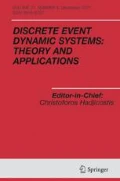Abstract
The first part of the paper presents a model of a complex subway network that includes an operational cost and social costs measured in terms of passenger waiting times. We reformulate the model with a simple discrete event simulation model that considerably reduces the complexity of the simulation. The simplified model uses conditional expectations to filter out rapid dynamics, and it can be interpreted in terms of a subway network with “fluid” passenger levels. Because this network only sees train movements and no individual passengers are described, we call it the “ghost” model.
In the second part of the paper, we explore the benefits of using stochastic approximations to adjust the service level (headway) of different subway lines as the network is operating, thus learning passenger traffic patterns and adaptively seeking the best service values. Our formulation of the ghost model is amenable for decentralized estimation of gradients of the cost function with respect to the control parameters (the line headways) and we use ersatz estimation methods to formulate a control scheme that uses minimal measurements and virtually no overhead.
Similar content being viewed by others
References
Bookbinder, J. H., and Désilets, A. 1992. Transfer optimization in a transit network. Transp. Sci. 26: 106–118.
Chung, K. L. 1979. Elementary Probability Theory with Stochastic Processes, 3rd edition. New York: Springer-Verlag.
Fu, M., and Hill, S. 1997. Optimization of discrete event systems via simultaneous perturbation stochastic approximation. IIE Trans. 29: 233–243.
Glasserman, P. 1991. Gradient Estimation via Perturbation Analysis. Boston: Kluwer Academic.
Heidergott, B., and de Vries, R. 2001. Towards a control theory for transportation networks. DEDS 11: 371–398.
Kushner, H. J., and Yin, G. 1997. Stochastic Approximation and Applications. New York: Springer Verlag.
Miller-Hooks, E., and Mahmassani, H. 2003. Path comaprisons for a priori and time-adaptive decisions in stochastic, time varying networks. Eur. J. Oper. Res. 146: 67–82.
Noriega, Y. 2000. Optimisation de fréquences dans un réseau de transport, Mémoire de maîtrise. Département d’informatique et de recherche opérationnelle, Université de Montréal.
Ross, S. M. 1993. Introduction to Probability Models, 5th edition. San Diego: Academic Press.
Sansó, B., and Girard, P. 1997. Instantaneous power peak reduction and train desynchronization in subway systems. Transp. Sci. 31: 312–323.
Spiess, H., and Florian, M. 1989. Optimal strategies: A new assignment model for transit networks. Transp. Res. B23:83–102.
“SSC User’s guide. A stochastic simulation library in C.” http://www.iro.umontreal.ca/dift6561/c/guide.pdf.
Vázquez-Abad, F. J., and Heidergott, B. 2004. Gradient estimation for a problem in public transportation: A comparison of SPA, SF and MVD. Proc. of WODES’04, IFAC. Reims, France, pp. 241–246.
Vázquez-Abad, F., and Zubieta, 1999. Generalizations of the surrogate estimation approach for sensitivity analysis. In Proc. of the 1999 IEEE CDC, pp. 1796–1802.
Vázquez-Abad, F., and Zubieta, L. 2000. Distributed stochastic approximation for adaptive frequency allocation in subway networks. In Proc. of the 2000 IEEE CDC, pp. 1796–1802.
Vázquez-Abad, F., and Zubieta, L. 2003. Simplifying sensitivity analysis in subway control. In Proc. of the Industrial Simulation Conference, Valencia, Spain, EUROSIS, pp. 423–428.
Author information
Authors and Affiliations
Corresponding author
Rights and permissions
About this article
Cite this article
Vázquez-Abad, F.J., Zubieta, L. Ghost Simulation Model for the Optimization of an Urban Subway System. Discrete Event Dyn Syst 15, 207–235 (2005). https://doi.org/10.1007/s10626-005-2865-9
Revised:
Published:
Issue Date:
DOI: https://doi.org/10.1007/s10626-005-2865-9




